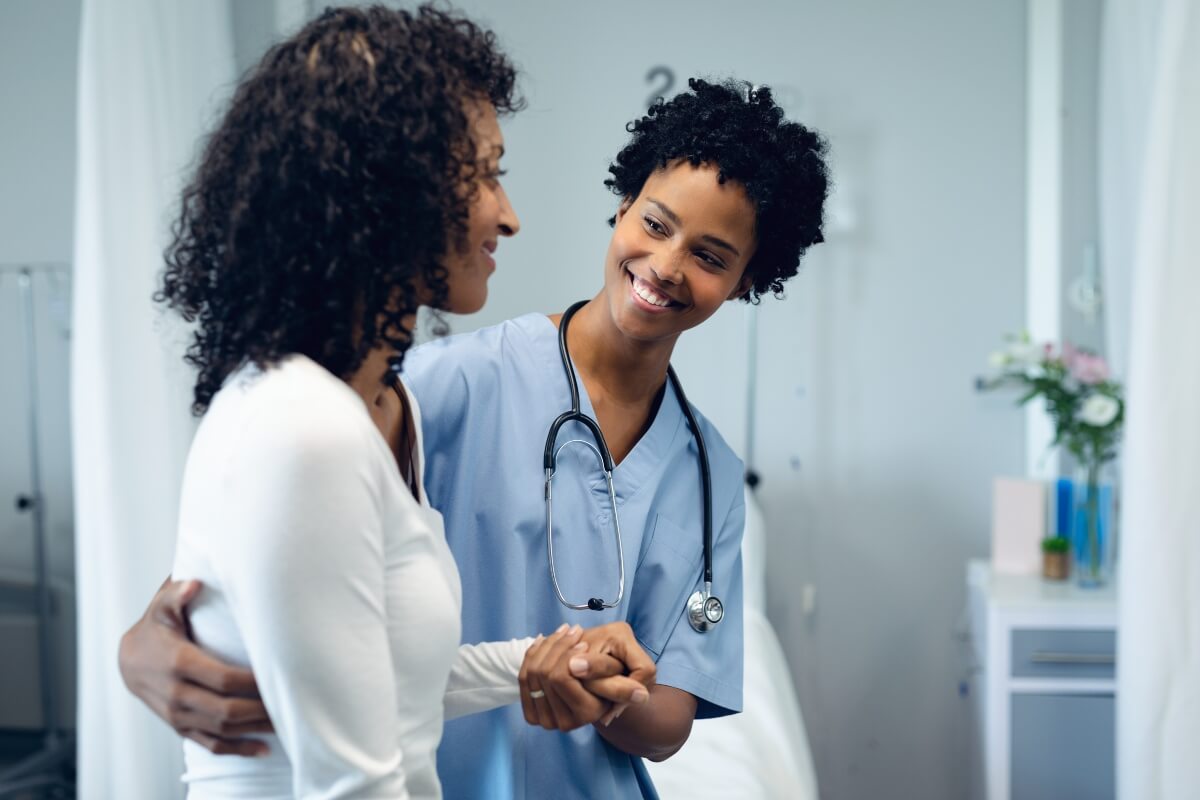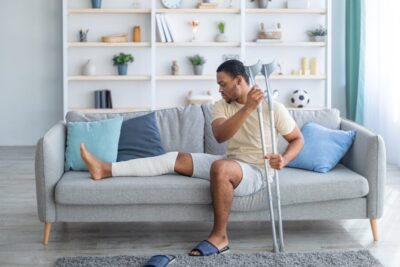coMra is a powerful ally to anyone recovering from an operation. Use your coMra device to treat post-surgery pain and reduce common complications like scarring.
Having a surgical procedure comes with its own set of risks, so it’s important to take good care of yourself when recovering from an operation. You can use your coMra device to manage post-operative pain and reduce common post-surgery complications, such as infection and scarring.
Download the coMra e-book for more information on coMra therapy
COMMON COMPLICATIONS AFTER SURGERY
Common health issues following anaesthesia and surgery include:1
- Pain
- Bruising and swelling
- Shortness of breath
- Scarring
- Secondary infection
- Constipation
- Difficulty urinating
Other more serious complications include blood clots and deep vein thrombosis.1
coMra is a powerful ally to anyone recovering from an operation. Research shows that low-level laser therapy (LLLT) is efficient in healing post-operative wounds2 and reducing post-operative pain.3
BENEATH THE SURFACE: coMra FOR KELOIDS AND ADHESIONS
As the body attempts to heal itself after an operation, scarring complications like keloids and adhesions can start to form.4,5
- Keloids – growth of irregular fibrous tissue at the site of a surgical cut (or other skin injury).4
- Adhesions – bands of scar tissue that form internally between two surfaces inside the body and “stick” them together.5
Keloids may be itchy, tender or painful, and can also cause emotional distress as they tend to be highly visible.4 Adhesions can cause pain by pulling on the nerves in the organs or tissues, and if they are located in the intestines, they can cause blockages.5
Low-level laser therapy has been proven to successfully treat troublesome keloids and adhesions by breaking down fibrous tissue and supporting healthy cell regeneration, even years after surgery.6-9
How it works: Here’s a brief summary of the science behind it. Fibroblasts are a type of cell in the body, involved in the formation of fibrous connective tissue.10 Fibroblasts produce collagen proteins, which support the skin’s structure and facilitate skin healing. But an overproduction of collagen (“overhealing”) in a certain area can cause problems like keloids and adhesions.11 LLLT reduces the accumulation of fibroblast cells in the affected area, to reduce scar tissue and improve the skin’s appearance.6-9
Research shows that LLLT is a non-invasive, side effect-free treatment that not only prevents the formation of excess scar tissue and adhesions after surgery,12 but can treat long-time scars after they have formed.6-9
coMra PROTOCOLS FOR POST-SURGERY RECOVERY
coMra devices offer a wide variety of protocols to treat many other possible complications of surgery.
General recovery13
- UNIVERSAL 6 (VITALITY) improves general wellbeing and relieves fatigue, and also acts as a long-term preventative healthcare protocol. It also promotes healing after surgery and reduces the risk of secondary post-surgery complications.
- STOMATOLOGY 1 assists with recovery from dental surgery.
- UNIVERSAL 7 (NERVOUS SYSTEM) treats emotional exhaustion and stress, which can occur after a major event like an operation. It also assists with breathing difficulties, which can sometimes occur as a result of anaesthesia.
- IMMUNOLOGY 6 helps to prevent acute respiratory conditions which can be contracted in hospital or when your immunity is low. This includes colds, flu and COVID-19.
- IMMUNOLOGY 7 helps to treat the acute respiratory infections mentioned above.
Scarring and bruising13
UNIVERSAL 6 can be used together with SURGERY 2 to help minimise scar tissue formation after surgery.
- SURGERY 2 is useful for healing surgical cuts and other traumatic wounds.
- UNIVERSAL 3 (BLOOD) is part of the SURGERY 2 treatment. While SURGERY 2 targets the cut or wound directly, UNIVERSAL 3 targets key points along major arteries to promote healthy circulation and overall wellbeing.
- SURGERY 1 assists with bruising and abrasions.
Pain management13
- NEUROLOGY 17 treats post-traumatic neuralgia (nerve pain).
Swelling and inflammation13
- SURGERY 3 is designed to treat swelling and inflammation of tissue, which can be common post-operative side effects.
- SURGERY 3 can also be combined with SURGERY 7 to treat oedema in the lower limbs, and swelling caused by fluid retention (lymphedema).
Other complications13
- SURGERY 7 assists with deep vein thrombosis (DVT).
- SURGERY 10 is a protocol designed to treat post-operative enteroparesis (flaccid muscles in the intestinal walls).
- GASTROENTEROLOGY 6 helps to relieve constipation and indigestion.
- NEPHROLOGY 2 treats urethritis (infection of the urethra) and NEPHROLOGY 3 treats cystitis (infection of the bladder).
Instructions for use in the latest coMra User Guide.
POST-SURGERY RECOVERY TIPS
If you’ve recently had an operation, be sure to follow your healthcare practitioner’s advice for optimal recovery.14
- Take time to rest and avoid overexerting yourself.
- Drink plenty of fluid to stay hydrated.
- Start moving around as soon as you can safely do so, to promote circulation and prevent blood clots.
- Gentle physical activity also helps to improve sluggish digestion.
- Do physical therapy exercises as recommended by your healthcare practitioner.
- Take any prescribed medications as directed.
NOTE: coMra is a powerful modality. The uses described above are those recommended by the coMra User Guide. Experience over 10 years has shown that in the case of most chronic conditions, treatments can also be spread out to once or twice per week, without taking the breaks outlined in the guide.
References:
1 Common complications after surgery. WebMD. 2020.2 Herascu N, Velciu B, Calin M, et al. Low-level laser therapy (LLLT) efficacy in post-operative wounds. Photomed Laser Surg. 2005;23(1):70-3.3 Hamid MA. Low-level laser therapy on postoperative pain after mandibular third molar surgery. Ann Maxillofac Surg. 2017;7(2):207-216.4 Keloids. American Academy of Dermatology Association.5 Adhesions, general and after surgery. WebMD. 2022.6 Fujii S, Ohshiro T, Ohshiro T, el al. Low reactive level laser therapy (LLLT) for the treatment of hypertrophic scars and keloids. A re-introduction. Laser Therapy. 2008;17(1):35-43..7 Barolet D, Boucher A. Prophylactic low-level light therapy for the treatment of hypertrophic scars and keloids: A case series. Lasers Surg. Med. 2010;42:597-601.8 Freitas CP, Melo C, Alexandrino AM, et al. Efficacy of low-level laser therapy on scar tissue. J Cosmet Laser Ther. 2013;15(3):171-176.9 Avci P, Gupta A, Sadasivam M, et al. Low-level laser (light) therapy (LLLT) in skin: stimulating, healing, restoring. Semin Cutan Med Surg. 2013;32(1):41-52. 10 Fibroblast. National Human Genome Research Institute. 2022. 11 Keloid scars: Advanced therapies and research to break the ‘overhealing’ cycle. UT Southwestern Medical Center. 2019. 12 Teixeira MLCD, Vasconcellos LS, Oliveira TG, et al. Prevention of abdominal adhesions and healing skin after peritonectomy using low level laser. Lasers Surg Med. 2015;47(10):817-23..13 coMra User Guide.14 Mistakes after surgery that slow your recovery. WebMD. 2022.


 UNIVERSAL 6 can be used together with SURGERY 2 to help minimise scar tissue formation after surgery.
UNIVERSAL 6 can be used together with SURGERY 2 to help minimise scar tissue formation after surgery.

